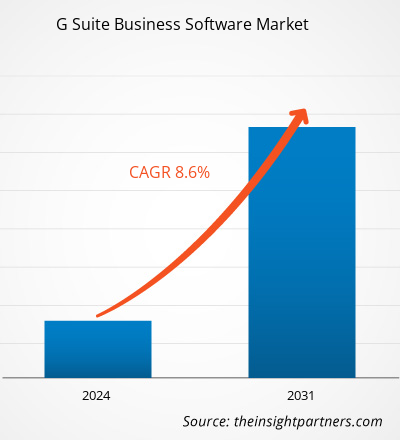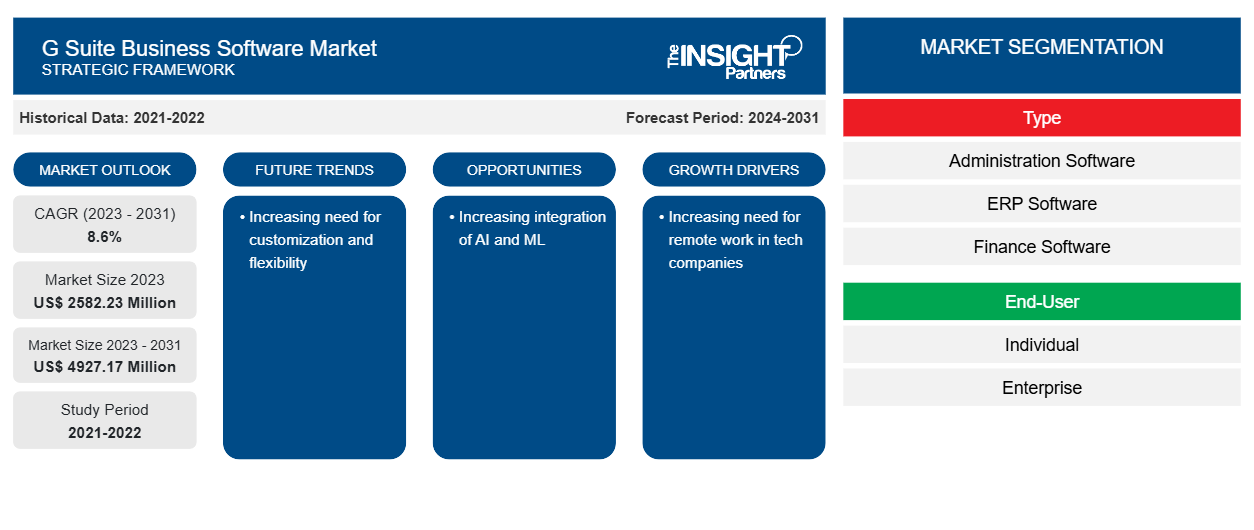Se proyecta que el tamaño del mercado de software empresarial G Suite alcance los 4927,17 millones de dólares en 2031, frente a los 2582,23 millones de dólares en 2023. Se espera que el mercado registre una CAGR del 8,6 % durante el período 2023-2031. Es probable que la creciente necesidad de personalización y flexibilidad siga siendo una tendencia clave en el mercado.CAGR of 8.6% during 2023–2031. The increasing need for customization and flexibility is likely to remain a key trend in the market.
Análisis del mercado del software empresarial G Suite
G Suite permite a las empresas y organizaciones utilizar el conjunto de herramientas de colaboración y productividad basadas en la nube de Google al final de sus procesos comerciales. Varios desarrolladores y proveedores de soluciones externos ofrecen una gestión y gobernanza superiores de las soluciones de G Suite en función de los requisitos de las empresas. Calendly ofrece una solución para G Suite que funciona a la perfección con Google Calendar para administrar todas las reservas y actividades relacionadas con la programación. Mixmax ofrece soluciones de calendario y una plataforma de productividad de correo electrónico para ventas, éxito del cliente, contratación, operaciones de ventas, liderazgo y emprendedores. Las empresas externas proporcionan herramientas adicionales para G Suite que mejoran la productividad y la capacidad de gestión de las empresas y brindan a los clientes requisitos personalizados.
Descripción general del mercado del software empresarial G Suite
G Suite es un conjunto de aplicaciones de software como servicio (SaaS) diseñado y desarrollado por Google. Estas aplicaciones basadas en la nube se centran en diferentes áreas, como los negocios, la colaboración, la productividad y la educación. Gmail, Docs, Sheets, Drive, Calendar, Google+, Slides, Forms, Sites, Hangouts y Keep son las principales herramientas de G Suite disponibles por Google. G Suite es un recurso valioso tanto para empresas como para particulares de todo el mundo.
Personalice este informe según sus necesidades
Obtendrá personalización en cualquier informe, sin cargo, incluidas partes de este informe o análisis a nivel de país, paquete de datos de Excel, así como también grandes ofertas y descuentos para empresas emergentes y universidades.
- Obtenga las principales tendencias clave del mercado de este informe.Esta muestra GRATUITA incluirá análisis de datos, desde tendencias del mercado hasta estimaciones y pronósticos.
Impulsores y oportunidades del mercado del software empresarial G Suite
Creciente necesidad de trabajo remoto en empresas tecnológicas
Los empleadores están cada vez más interesados en puestos en empresas que ofrecen modelos de trabajo remoto o híbrido, y cada vez más empleadores reconocen esta tendencia. De 2021 a 2022, un informe del sitio web de anuncios de empleo FlexJobs.com reveló que los anuncios de puestos remotos aumentaron del 12 % el año anterior al 12 %. La popularidad del trabajo remoto se ha convertido en un factor importante y es probable que aumente a medida que los empleadores refinen sus políticas de empleo sobre el trabajo desde casa. Por lo tanto, la creciente necesidad de trabajo remoto en las empresas de tecnología está impulsando el mercado de software empresarial G Suite.FlexJobs.com revealed that listings for remote positions rose from 12% the previous year to 12%. The popularity of remote work has become a major factor and is likely to rise as employers refine their employment policies on working from home. Therefore, the increasing pen need for remote work in tech companies is driving the G suite business software market.
Aumento de la integración de la IA
Con la ayuda de la IA y el ML, G Suite añade herramientas de seguridad. Varias empresas están implementando el software empresarial de G Suite con tecnologías de IA y ML. Por ejemplo, en 2020, el gigante de las búsquedas anunció varias actualizaciones de G Suite mediante el uso de IA, su conjunto de aplicaciones que se parecen a Google Docs y Sheets pero están diseñadas para la oficina. La empresa anunció esto durante su conferencia anual Google Cloud Next en San Francisco. Por lo tanto, la creciente integración de la IA con el software empresarial de G Suite está creando más oportunidades para el mercado.deployoing G suite business software with AI and ML technologies. For instance, in 2020, the search giant announced several updates to G Suite by using AI, its set of apps that resemble Google Docs and Sheets but are tailored for the office. The company announced this during its annual Google Cloud Next conference in San Francisco. Therefore, the increasing integration of AI with G Suite business software is creating more opportunities for the market.
Informe de análisis de segmentación del mercado de software empresarial G Suite
Los segmentos clave que contribuyeron a la derivación del análisis del mercado del software empresarial G Suite son el tipo y el usuario final.
- Según el tipo, el mercado de software empresarial de G Suite se divide en software de administración, software ERP, software financiero, software de RR.HH. y otros. El segmento personalizado tuvo una mayor participación de mercado en 2023.ERP software, finance software, HR software, and others. The customized segment held a larger market share in 2023.
- Por usuarios finales, el mercado se segmenta en individuos, empresas y otros.
Análisis de la cuota de mercado del software empresarial G Suite por geografía
El alcance geográfico del informe de mercado de software empresarial G Suite se divide principalmente en cinco regiones: América del Norte, Asia Pacífico, Europa, Medio Oriente y África, y América del Sur y Central.
La región APAC domina el mercado de software empresarial G Suite. El mercado de software empresarial G Suite en esta región está creciendo debido a diversos factores, como el aumento de las iniciativas de las organizaciones para mejorar su seguridad y la presencia de proveedores dominates the G Suite business software market. The G suite business software market in this region is growing due to various factors, such as increasing organizations' initiatives to improve their security and the presence of well-established G suite business de software empresarial G Suite bien establecidos .
Perspectivas regionales del mercado del software empresarial G Suite
Los analistas de Insight Partners explicaron en detalle las tendencias y los factores regionales que influyen en el mercado de software empresarial G Suite durante el período de pronóstico. Esta sección también analiza los segmentos y la geografía del mercado de software empresarial G Suite en América del Norte, Europa, Asia Pacífico, Oriente Medio y África, y América del Sur y Central.

- Obtenga datos regionales específicos para el mercado de software empresarial G Suite
Alcance del informe de mercado del software empresarial G Suite
| Atributo del informe | Detalles |
|---|---|
| Tamaño del mercado en 2023 | US$ 2582,23 millones |
| Tamaño del mercado en 2031 | US$ 4927,17 millones |
| CAGR global (2023 - 2031) | 8,6% |
| Datos históricos | 2021-2022 |
| Período de pronóstico | 2024-2031 |
| Segmentos cubiertos | Por tipo
|
| Regiones y países cubiertos | América del norte
|
| Líderes del mercado y perfiles de empresas clave |
|
Densidad de actores del mercado del software empresarial G Suite: comprensión de su impacto en la dinámica empresarial
El mercado de software empresarial G Suite está creciendo rápidamente, impulsado por la creciente demanda de los usuarios finales debido a factores como la evolución de las preferencias de los consumidores, los avances tecnológicos y una mayor conciencia de los beneficios del producto. A medida que aumenta la demanda, las empresas amplían sus ofertas, innovan para satisfacer las necesidades de los consumidores y aprovechan las tendencias emergentes, lo que impulsa aún más el crecimiento del mercado.
La densidad de actores del mercado se refiere a la distribución de las empresas o firmas que operan dentro de un mercado o industria en particular. Indica cuántos competidores (actores del mercado) están presentes en un espacio de mercado determinado en relación con su tamaño o valor total de mercado.
Las principales empresas que operan en el mercado de software empresarial G Suite son:
- RANURA
- MAILTRACK.IO
- Calendario
- Compañía NetHunt Inc.
- Mixmax
- Salesforce.com inc.
Descargo de responsabilidad : Las empresas enumeradas anteriormente no están clasificadas en ningún orden particular.

- Obtenga una descripción general de los principales actores clave del mercado de software empresarial de G Suite
Noticias y novedades del mercado del software empresarial G Suite
El mercado del software empresarial G Suite se evalúa mediante la recopilación de datos cualitativos y cuantitativos a partir de una investigación primaria y secundaria, que incluye publicaciones corporativas importantes, datos de asociaciones y bases de datos. A continuación, se enumeran algunos de los avances en el mercado del software empresarial G Suite:
- Google rebautizó G Suite, un conjunto de herramientas de colaboración y productividad en línea para empresas que incluye Gmail, Drive, Docs y Meet. El nuevo nombre es Google Workspace, un nombre que la empresa ya había insinuado cuando presentó por primera vez un conjunto de nuevas herramientas de colaboración e integraciones de Google Meet para el servicio a principios de este año. (Fuente: Google, comunicado de prensa, octubre de 2020)
- G Suite de Google incorporó nuevas herramientas de inteligencia artificial y seguridad. El gigante de las búsquedas anunció varias actualizaciones para G Suite, su conjunto de aplicaciones que se asemejan a Google Docs y Sheets, pero están diseñadas para la oficina. (Fuente: Tungsram Group, comunicado de prensa, julio de 2021)
Informe sobre el mercado de software empresarial G Suite: cobertura y resultados
El informe “Tamaño y pronóstico del mercado del software empresarial G Suite (2021-2031)” proporciona un análisis detallado del mercado que cubre las siguientes áreas:
- Tamaño del mercado del software empresarial G Suite y pronóstico a nivel global, regional y nacional para todos los segmentos clave del mercado cubiertos bajo el alcance
- Tendencias del mercado del software empresarial G Suite, así como dinámicas del mercado, como impulsores, restricciones y oportunidades clave
- Análisis detallado de las cinco fuerzas de Porter y PEST y FODA
- Análisis del mercado del software empresarial G Suite que abarca las tendencias clave del mercado, el marco global y regional, los principales actores, las regulaciones y los desarrollos recientes del mercado
- Análisis del panorama de la industria y de la competencia que abarca la concentración del mercado, el análisis de mapas de calor, los actores destacados y los desarrollos recientes del mercado de software empresarial G Suite
- Perfiles detallados de empresas
- Análisis histórico (2 años), año base, pronóstico (7 años) con CAGR
- Análisis PEST y FODA
- Tamaño del mercado, valor/volumen: global, regional y nacional
- Industria y panorama competitivo
- Conjunto de datos de Excel
Informes recientes
Informes relacionados
Testimonios
Razón para comprar
- Toma de decisiones informada
- Comprensión de la dinámica del mercado
- Análisis competitivo
- Información sobre clientes
- Pronósticos del mercado
- Mitigación de riesgos
- Planificación estratégica
- Justificación de la inversión
- Identificación de mercados emergentes
- Mejora de las estrategias de marketing
- Impulso de la eficiencia operativa
- Alineación con las tendencias regulatorias





















 Obtenga una muestra gratuita para - Mercado de software empresarial de G Suite
Obtenga una muestra gratuita para - Mercado de software empresarial de G Suite